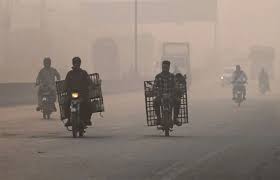Punjab is still grappling with thick smog as the pollution level continues to rise, even after several measures by the government to control it. The air quality has worsened, especially with the dropping temperatures. Lahore has once again topped the list of the world’s most polluted major cities. Meanwhile, Multan is facing the worst air quality in Pakistan, with levels exceeding the “hazardous” category, which poses severe health risks for residents exposed for extended periods.
The dense, smog-filled air has now moved from Punjab to Khyber Pakhtunkhwa, engulfing the provincial capital, Peshawar, and surrounding areas. As of 8:30 AM, the air quality index (AQI) in Lahore hit 565, according to real-time data from the Swiss group monitoring air pollution. The level of PM2.5 particles—small enough to penetrate deep into the lungs—was a staggering 71.6 times above the safe limits set by the World Health Organization.
Multan’s AQI was even more alarming, reaching 955, while in Peshawar, it stood at 592, far beyond the 300 threshold, after which air is deemed hazardous for human health.
In addition to Lahore and Multan, several other cities in Punjab, including Bahawalpur and Rajanpur, are also covered in thick smog, significantly reducing visibility. This situation led to major traffic disruptions. Key motorways were closed to prevent accidents. The M2 motorway was shut from Lahore to Bhera, while the M3 was blocked from Lahore to Durkhana. Similarly, the M4 from Multan to Pindi Bhattian and the M5 from Multan to Sukkur were also closed. Even the Lahore-Sialkot Motorway was blocked. Visibility on the roads was so poor that Motorway M1, running from Peshawar to Rashakai, was shut down, as was the M2 from Bheera to Kot Momin.
In Multan, the entry of heavy vehicles was banned to ease traffic flow. Parts of upper Sindh, bordering Punjab, have also been affected by the polluted air, causing the closure of the M5 from Sukkur to Rahim Yar Khan.
The severe smog has also led to multiple road accidents, resulting in casualties. A fatal crash in Rahim Yar Khan claimed one life, and six others were injured. In light of these accidents, traffic authorities are urging drivers to exercise extra caution. They advise traveling only during daylight hours and using fog lights for safety.
The dense smog also disrupted air and rail travel. At Faisalabad and Multan airports, several flights were either diverted or canceled. Three flights bound for these cities were rerouted to other airports, and two from Multan were called off. The fog caused delays for 36 flights across the country. For example, two flights from Jeddah to Multan were canceled, while a Dubai-bound flight from Multan was diverted to Karachi. Similarly, train services were heavily impacted. The Tezgam Express, traveling from Karachi to Rawalpindi, was delayed by three hours. The Pak Business train, running from Lahore to Karachi, faced an eight-hour delay.
The severe air pollution has prompted authorities to close public spaces and ban outdoor activities in affected cities until November 17. The rapid deterioration of air quality is leading to an increase in health issues such as eye and throat infections, as well as respiratory diseases. The government is advising people to stay indoors and keep windows and doors closed. Wearing masks is strongly recommended.
Punjab’s smog problem has worsened this year due to a mix of local emissions, crop residue burning, and polluted air from neighboring India, where air quality is also dangerously low. South Asia faces regular bouts of pollution, with trapped dust and industrial emissions worsening the situation.
As Punjab continues to battle smog, authorities are calling for increased awareness and urgent action to curb pollution in the coming days.


